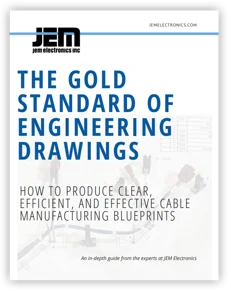A BOM or Bill of Materials is a list containing every item or piece needed to manufacture a product. It is a critical engineering drawing standard that comprises quantity and procurement details for assemblies, parts, raw materials, sub-assemblies, and all the other components needed to build a product.
The product for which a BOM is created can be a final product or a semi-finished one which will later become a part of the final product. Multiple BOMs can be found for a single product if the final product has a variant by size, color, or specification.

As an essential document, manufacturers must ensure that their BOMs are up-to-date, detailed, and accurate so that all the critical details related to the product are available for manufacturing.
Types of Bill of Materials
BOMs are of two types at a higher level: Engineering Bill of Materials (EBOM) and Manufacturing Bill of Materials (MBOM).
EBOM
EBOMs are produced during the product design phase, usually by design engineers using CAD software. EBOMs typically list items from the engineering perspective. These BOMs typically focus on the final assemblies or a list of parts that make up the final product. For example, the EBOM of a Printed Circuit Board Assembly (PCBA) designed by an engineer will consist of a list of resistors, capacitors, chips, and other parts that will form the final assembly.
While EBOMs are not detailed, their accuracy is critical since MBOMs are directly dependent on EBOMs. Any error or inaccuracy in EBOM will lead to production delays, inventory mismatch, unnecessary revisions, and other production issues.
MBOM
The bill of materials for manufacturing enables the final transition of a product from its conceptual phase to a real-world object. The more depth and detail the MBOMs possess, the more efficient and cost-effective will be the manufacturing process.
Apart from the EBOM data, MBOMs typically include all the details required to manufacture a shippable product. As such, these documents comprise elements such as packaging material, assembly process information, the tooling used, supplier information, etc. Ideally, MBOMs must be developed together by the design engineer, product developer, and manufacturing team to ensure document accuracy and that everyone is on the same page.
Elements of a Good BOM
A good BOM contains all the required information of all the product components and does not leave any scope of errors for the stakeholders. Considering the example of PCB manufacturing, an ideal BOM typically includes the following elements.
- BOM Level: It is a unique number that shows where each part or assembly fits in the BOM hierarchical structure. These levels help users navigate the BOM document and get a clear understanding of the main assembly.
- Part Number: It is a unique number assigned to each part so that the assembling team can identify the exact component needed for the PCB assembly.
- Manufacturer Name: It is also essential to include the manufacturer’s name to help those using the BOM find the right part and check its availability.
- Description: This field consists of more details about the part. E.g., dimensions, color, voltage, and other specifications.
- Quantity: The quantity of each part needed is another essential BOM element.
- Type of Procurement: This field provides information on how the part will be procured. E.g., purchased, off-the-shelf, custom-made, etc.
- Placement Method: In the case of PCB manufacturing, the BOM must also include the placement method or surface mounting technology used to attach all the components to the board.
- Board Layer: The board layer indicates the layer of the board where the component will be attached. E.g., top, bottom, multi-layer, middle, etc.
- Phase: The phase category indicates where the parts are in their lifecycle
- Comments and Notes: While not mandatory, this section can be used to mention any specific comments, change requests, or other details that don’t fit in other categories.

Download Our eBook to Learn More About BOMs
Download JEM’s new “Gold Standard of Engineering Drawings” eBook for in-depth information on BOMs and engineering drawings for electronics manufacturing. This handy ebook is a must-have for everyone working in the field of electronics engineering, product design, and manufacturing. Download your copy today!


